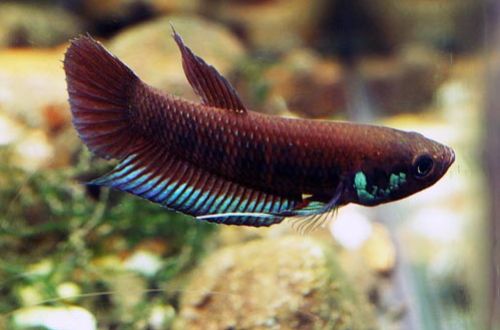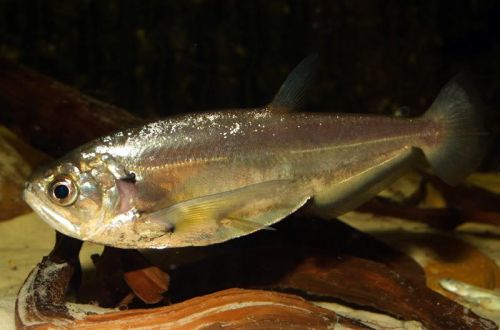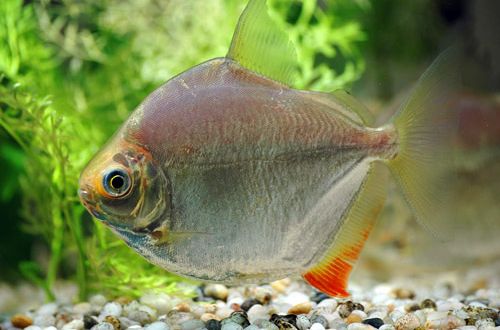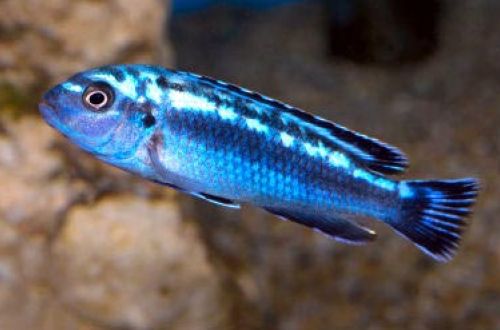
cockerel krataios
Betta krataios or Cockerel krataios, scientific name Betta krataios, belongs to the Osphronemidae family. Belongs to the group of fighting fish, famous for their temperament and brightness of color. True, all this does not apply to this species, which largely led to its weak popularity in amateur aquariums.

Contents
Habitat
It comes from Southeast Asia from the island of Borneo. It is considered endemic to the lower basin of the Kapuaz River, located in the Indonesian province of West Kalimantan (Kalimantan Barat). Inhabits shallow forest rivers and streams, swampy areas. Little light penetrates through the dense crowns of trees, so the reservoirs have low illumination. Aquatic plants are practically absent, which is compensated by rich dense coastal vegetation. The bottom of the rivers is covered with a thick layer of fallen leaves, branches and other woody structures, pierced by numerous roots. Due to the abundance of plant organic matter, the water acquired a rich brown hue – the result of the release of tannins during decomposition.
Brief information:
- The volume of the aquarium – from 40 liters.
- Temperature – 22-28°C
- Value pH — 5.0–7.0
- Water hardness – 1–5 dGH
- Substrate type – any
- Lighting – subdued
- Brackish water – no
- Water movement – little or no
- The size of the fish is about 4 cm.
- Food – any food
- Temperament – peaceful
- Content – singles, pairs or in a group
Description
This species was identified relatively recently and was previously considered a variety of Betta dimidiata, therefore it is often found on sale under this name. Both fish are really very similar and differ in the shape of the tail. In Betta dimidiata it is larger and rounder.
Adults reach a length of about 4 cm. The fish has an elongated strong body, which is reflected in the scientific name of this species. The word “Krataios” just means “strong, strong.” The coloration is dark gray with turquoise hues on the underside of the head and on the edges of the fins. Sexual dimorphism is weakly expressed. Males, unlike females, have long fin tips.
Food
Omnivorous species, accepts most popular foods designed for aquarium fish. The daily diet may consist of dry flakes, granules, combined with live or frozen artemia, daphnia, bloodworms and similar products.
Maintenance and care, arrangement of the aquarium
Recommended aquarium sizes for one or two fish start at 40 liters. Betta krataios is not demanding in terms of design. For example, many breeders, wholesalers, and pet stores often use half-empty tanks, where there is nothing more than equipment. Of course, such an environment is not optimal, so in a home aquarium it is desirable to recreate conditions close to those in which fish live in nature. The main elements of the decor can be a dark substrate, driftwood, thickets of shade-loving aquatic plants, including floating and various decorative items.
If desired, you can add the leaves of some trees, previously soaked in water and placed on the bottom. They are not only part of the design, but also serve as a means of giving the water a composition characteristic of natural reservoirs in the natural habitat due to the release of tannins in the process of decomposition.
The key to successful long-term management is water quality. Accumulation of organic waste and sharp fluctuations in temperature and values of hydrochemical parameters should not be allowed. The stability of water conditions is achieved due to the uninterrupted operation of the equipment, primarily the filtration system, and the regularity of the mandatory maintenance procedures for the aquarium.
Behavior and Compatibility
Although the Cockerel krataios belongs to the Fighting Fish, it does not have their characteristic behavioral features. This is a peaceful calm species, which large and overly mobile neighbors can intimidate and force out to the periphery of the aquarium. The latter is fraught with malnutrition if the Betta is driven away from the feeder. It is recommended to keep alone, in a pair of male / female, in a community with relatives and together with other non-aggressive fish of a comparable size.
Breeding / breeding
In favorable conditions, successful cases of breeding are not rare. Fish have developed an unusual way to protect future offspring. During spawning, the male takes the eggs into his mouth and carries them throughout the entire incubation period, which takes one to two weeks. The breeding process is accompanied by mutual courtship and a “dance of hugs”, during which the fish take root to each other.
Fish diseases
The cause of most diseases is unsuitable conditions of detention. A stable habitat will be the key to successful keeping. In the event of symptoms of the disease, first of all, the quality of the water should be checked and, if deviations are found, measures should be taken to correct the situation. If symptoms persist or even worsen, medical treatment will be required. Read more about symptoms and treatments in the Aquarium Fish Diseases section.





